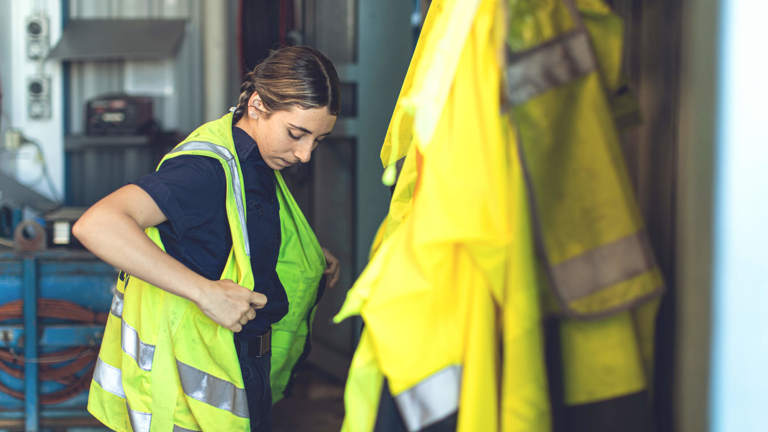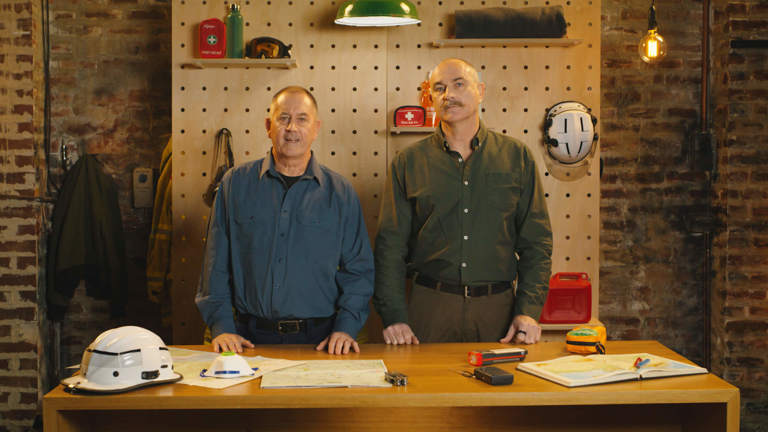Being ready for bushfire season is all about planning ahead and preparing your home and property well before the fire season starts in your region.
And with climate change impacting the length of bushfire seasons across the country, it’s never been more important to keep on top of your garden and outdoor areas, no matter where you live.1
“It’s best to get started before the fire season begins,” says Jim Smith, volunteer firefighter and former Deputy Commissioner of Fire and Rescue NSW.
“Once the job is done, it’s only a matter of just doing a quick trim on the trees, a mow of the lawn and a quick sweep up of all the leaf litter each weekend.”
Fire services say that a well-tended property is easier to defend and reduces the risk to surrounding properties.2 In some cases, Jim says, firefighters may be forced to prioritise the defence of well-prepared homes to make the most of limited resources.
“I remember I went to one place, and they had piles of wood underneath their wooden deck, so I just told them, ‘If the fire comes through, we won’t be able to save your house’,” Jim shares.
“We wouldn’t even try to defend your house – we would ask you to evacuate straight away and assist you to evacuate if necessary.”
To help you start preparing your home and property, we’ve created some useful checklists for various property types, along with resources for those who may not be able to prepare for bushfire season themselves.
Download the checklistOutside jobs to do for rural residents
Even if you think you're up-to-date on best practices for preparing your home and property for bushfire, Jim says it's always worth triple-checking to ensure you're keeping up with the latest guidance.1
“The changing intensity of fires means maybe the 50 metres you had cleared between your property and the treeline isn’t enough anymore.”

Our bushfire expert suggests you:
- Make sure you have large, cleared paddocks around your home and valuable assets to stop or slow fire
- Use rocks and pavers for landscaping around buildings; avoid combustible mulch3
- Make sure you have firefighting equipment such as mobile tanks with pumps and hoses, as well as fixed tanks, petrol or diesel pumps and generators, all in working order
- Clear all leaf litter from the roof, gutters and ground
- Apply metal fly screen mesh over vent holes to stop embers getting under the house or into the roof
- Have enough hoses to protect all buildings and surrounding areas to extinguish spot fires caused by flying embers
- If you have a pool, a tank or a dam, put a Static Water Supply (SWS) sign at the entrance to your property. In New South Wales, the Rural Fire Service and Fire and Rescue (FRNSW) provide free SWS signs for properties with suitable water supplies4
- Make sure there’s adequate access to your property for fire trucks (of at least four metres in width and height, with a turn-around area)
- Practise your animal emergency plan – like humans, animals behave differently under stress, so it’s important to build familiarity with steps such as getting in or out of a trailer
- Prepare a safe zone, such as a heavily grazed or ploughed paddock or a large, cleared stockyard, for animals that stay behind
- Mark or tag livestock for easy identification.
For more tips, see this list from the NSW Rural Fire Service.2
Jim also recommends taking the following steps to make your home more resistant to bushfires (ensuring any changes meet your local building codes):
- Enclose open areas under decks and floors where embers might fly in.
- Install metal gutter guards.
- Repair damaged or missing roof tiles.
- Install fine metal mesh screens on windows and doors.
- Install bi-fold mesh screens around balconies that can be opened or closed to reduce heat load during a bushfire.
- Fit seals around doors and windows to eliminate gaps.
- Repair any gaps in external walls other than those required by design, such as ventilation or weep holes.
- Install shutters made of fireproof sheeting over glass surfaces.
- Add fireproof insulation such as mineral wool or fibreglass.
- Consider adding external and internal sprinkler systems supplied by a large concrete water tank.
Outside jobs to do for semi-rural residents
Australians living in semi-rural settings need to be especially vigilant about bushfires, as this urban-bush interface – as firefighters call it – is where bushfires cause significant losses each year and where preparation by homeowners most often falls short.5
“Semi-rural areas are where the bush meets urban infrastructure and where the bulk of property loss occurs because you have heavy fuel loads for bushfires coming up against urban areas, acreages and housing developments,” explains Jim.
If you live in a semi-rural area, here are some of the outdoor jobs Jim suggests you tackle:
- Clear a space between the surrounding bush and your property, taking caution to ensure any felled vegetation doesn’t damage the home, as this may impact your ability to make a home insurance claim. Local planning regulations in your area will dictate how much land you are permitted to clear, so check with local authorities, as this varies widely. If your house is nestled in bush, it’s much harder for firefighters to defend, Jim says.
- Ensure all lawns are kept mowed short.
- Remove combustibles such as woodpiles, wooden outdoor furniture and mulch from around your home.
- Clear all ground litter and roof litter.
- If you have a water source such as a tank or pool, get a petrol- or diesel-powered pump to help put out small fires and ember attacks.
- Identify potential water sources for firefighters, including hydrants, water tanks, pools, dams and creeks. In NSW, the Rural Fire Service and FRNSW provide free SWS signs for properties with suitable water supplies.4
- Apply fly screen mesh over vent holes to stop embers getting under the house or into roofs.
- Make sure there’s adequate access to your property for fire trucks (of at least four metres in width and height, with a turn-around area).
For additional advice, refer to this list from the NSW Rural Fire Service.2
Jim also suggests taking the following steps to make your home more resistant to bushfires (ensuring any changes meet your local building codes):
- Enclose open areas under decks and floors where embers might fly in.
- Install metal gutter guards.
- Repair damaged or missing roof tiles.
- Install fine metal mesh screens on windows and doors.
- Install bi-fold mesh screens around balconies that can be opened or closed to reduce heat load during a bushfire.
- Fit seals around doors and windows to eliminate gaps.
- Repair any gaps in external walls other than those required by design, such as ventilation or weep holes.
- Install shutters made of fireproof sheeting over glass surfaces.
- Add fireproof insulation such as mineral wool or fibreglass.
- Consider adding external and internal sprinkler systems supplied by a large concrete water tank.
Outside jobs to do for suburban residents
The 2003 Canberra bushfires, which destroyed more than 500 properties and took four lives, showed that built-up urban areas of Australia aren’t immune from the devastating effects of bushfires.6 During that firestorm, embers were accountable for more than 90% of the ignitions that resulted in the destruction of homes.7
To minimise the risk of ember attack and house-to-house transference, Jim advises homeowners to reduce the amount of mulch close to their home.
“Mulch close to buildings aided the burning of buildings in Canberra by quickly catching on fire. It also assisted fire spread from home to home,” he says.
“Using mulch only in garden beds set away from your home and removing all combustibles that are close to your home will greatly aid your home’s chance of survival.”

If you live in a suburban area, Jim recommends tackling the following outdoor jobs ahead of fire season:
- Clear gutters and roof of leaf litter and debris.
- Trim back overhanging branches, taking caution to ensure any felled vegetation doesn’t damage the home, as this may impact your ability to make a home insurance claim.
- Keep lawns short and cleared of ground litter.
- Move combustibles such as woodpiles and wooden outdoor furniture away from your home.
- Clear combustible mulch from garden beds close to your home.
- Make sure you have hoses long enough to reach all corners of your block in case of ember attack.
- Identify and seal any unintended gaps in the roof and external cladding – embers can get through gaps as small as 2mm.8
- Identify water sources such as pools and water tanks for firefighters. In NSW, the Rural Fire Service and FRNSW provide free SWS signs for properties with suitable water supplies.4
- Make sure your pets are properly identified with a name tag or microchip (check your details are up to date on your state or territory microchip registry).
- Consider helping less able neighbours prepare their blocks – poorly prepared properties near you could spread fire to your home.
Where to find help if you can’t prepare your property yourself
If illness or disability means you’re unable to tackle these tasks yourself, Jim recommends talking to neighbours or family members to see if they can assist you. You could also book a service with a local handyman or gardener.
Community resources for elderly or disabled Australians vary across the country.
“In New South Wales, there is a program called AIDER where they will come and clean the gutters, clear the vegetation, rake it all up, and do all those sort of things,” says Jim.9
In other states and territories, support is more ad hoc. It may be worth contacting your local fire station or rural fire brigade, or a community organisation such as Rotary or Lions Australia, to request help.
For more expert tips to help you get bushfire ready, visit our you.prepared emergency content hub.
Jim Smith
Jim Smith is an active Rural Fire Service volunteer and former Deputy Commissioner for Fire and Rescue NSW. Jim served as NSW State Emergency Service Commissioner and is a recipient of the Australian Fire Service Medal (2008) and the NSW State Emergency Services Commissioner’s Commendation for Service (2015). He is General Manager of workplace mental health consultancy Ordinary Courage, and volunteers as a solicitor with Youth Law Australia. Youi is proud to partner with Jim in the creation of this bushfire preparedness content.
The content in this article has been prepared based on current government and emergency services guidelines and expert advice provided at the time of publishing. This information is subject to change. Please be sure to check for the latest information and always consider your personal circumstances regarding bushfire preparedness and response.
Where you have increased your cover or reduced your excess within 72 hours (or other period noted on your policy schedule) of a flood, storm, hail or bushfire occurring, cover will be limited to the amount that was effective prior to the change. Loss, damage or legal liability caused by, resulting or arising from flood, storm, hail or bushfire during the first 72 hours (or other period noted on your policy schedule) of your policy first being purchased is excluded unless certain conditions apply. Refer to the relevant Product Disclosure Statement for full T&Cs.
1 Source: CSIRO – Climate change: wildfire risk has grown nearly everywhere – but we can still influence where and how fires strike, July 2022
2 Source: NSW Rural Fire Service – Prepare your home
3 Source: CSIRO – Bushfire best practice guide
4 Source: NSW Rural Fire Service – Static Water Supply (SWS)
5 Source: Australian Institute for Disaster Resilience – Living with bushfires on the urban-bush interface, January 2020
6 Source: National Museum of Australia – Canberra bushfires
7 Source: University of NSW – UNSW Canberra researchers work with ACT Government to mitigate bushfire risks, May 2022
8 Source: Vic Government – Siting and general design considerations, September 2023
9 Source: NSW Rural Fire Service – AIDER



